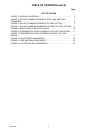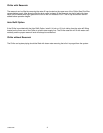
3
91961OPR
ELECTRICAL
All wiring must conform to the National Electric Code and any applicable local codes. The Chiller must be
PERMANENTLY wired by means of electrical conduit to a properly fused disconnect of proper amperage or
wired to a properly rated power cord and plugged into an outlet with the appropriate disconnect and amperage
rating. The electrical junction box located on the upper rear of the Chiller, includes a four-terminal strip for power
supply connections The DATA PLATE, located beside the junction box, indicates the actual phase, voltage and
amperage for each Chiller.
After the electrical connections are made, power must be supplied to the Chiller for a period of 12 hours (with
control switched off) to allow the compressor crankcase heater to warm the compressor lubricant.
CAUTION: On three phase applications, it is important that the rotation of the pump, when
supplied, is correct. Running the pump in reverse for more than a few seconds will result in
permanent pump damage. When the pump is running, shaft rotation must match the
direction indicated on the pump housing. If the rotation is incorrect, reverse two of the three
incoming power supply leads. The Phase Protection/3–Phase Monitor Option will prevent the
pump from operating backwards. See the option description.
Phase Protection / 3–Phase Option
The 3–Phase Monitor detects phase loss, low voltage, and phase reversal by continuously monitoring the
3–Phase power lines for abnormal conditions. When correct voltage and phase rotation are applied, the internal
relay will energize. A fault condition will de–energize the relay. When the fault is corrected, the monitor will auto-
matically reset. Both Trip and Norm condition indicators are provided on the relay to aid in adjustment and sys-
tem trouble–shooting.
This control is located in the enclosure labeled “Monitor” on top of the electrical box.
Phase Protection / 3–Phase Option Adjustment
The following procedure will allow the 3–Phase Monitor to achieve a trip point just below the nominal phase-to-
phase voltage, where the unit is applied.
Rotate the adjustment control fully clockwise, or until the red (Trip) indicator illuminated. Slowly rotate the ad-
justment control in a counter-clockwise direction, just until the green (Norm) indicator illuminates. At this point,
the 3–Phase Monitor is the most sensitive to irregular power line conditions. If nuisance tripping occurs, turn the
control slightly further counter–clockwise.
PLUMBING
Follow standard plumbing practices and local codes in making water connections. The Chiller inlet and outlet
connections are 3/4–inch or 1–inch FPT. Flexible hose and fittings are recommended for plumbing the system.
A No. 20 mesh strainer should be installed on the Chiller inlet to prevent foreign particles from entering the sys-
tem and should be cleaned monthly. Lines should be routed with as few bends as possible. Prevent lines from
running near radiators, hot water pipes, etc. Any lengths of tubing that are exposed to high ambient tempera-
tures should be insulated to prevent condensation and/or significant liquid heat loss.
Water-Cooled Condensers
Water-cooled units must be connected to a source of tap water of chilled water and a drain. The connections for
the water supply (3/4–inch FPT or 1–inch FPT) are located on the rear of the unit. These units are supplied with
a WATER REGULATING VALVE that allows only the required amount of water to pass through the condenser
for a given heat load. The water flow through the condenser can vary from 0 when the cooling system is in the
“OFF” cycle to approximately 5.0–gpm at maximum rated loads for 1–1/2 ton units and approximately 20–gpm
at maximum rated loads for 7–1/2 ton units. This valve is factory set to operate where the water supply temper-
ature ranges from 50_F (10_C) to 80_F (27_C) with a supply pressure of 30 to 60–PSIG. For temperatures or
pressure outside these ranges, contact our Technical Service Department for assistance in “field” adjustment of
the valve. Once the system as been properly plumbed, it is important that the circulation system be filled with
water.


















